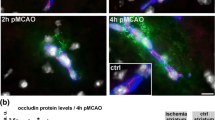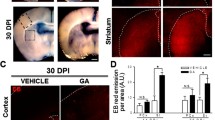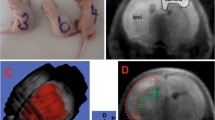Summary
Our previous studies have demonstrated toxicity in spinal cord neuronal systems of middle-aged rats with continuous intrathecal infusion of N-methyl-d-aspartate (NMDA). The present study was undertaken to determine when during the course of excitotoxicity vascular changes occur. The model used was intrathecal infusion of NMDA in the region of the lumbar enlargement of the spinal cord. Horseradish peroxidase (HRP) was used as a marker of vascular permeability alterations occurring in this model. Pathological changes were observed in the cord gray matter of all rats infused with 30–60 μg/min NMDA for 30 or 60 min. The changes consisted of swelling of dendrited which gave the neuropil a vacuolated appearance. There was expansion of the extracellular spaces in these areas and neurons were shrunken with pyknotic nuclei. These changes were more frequently encountered in the posterior than anterior horns and were specific for NMDA since they did not occur in NMDA-infused rats pretreated with MK-801, a specific NMDA antagonist. Endothelial dysfunction manifested as increased permeability to HRP. This was a consistent finding in all rats infused with the higher dose of NMDA and was less frequent in those infused with 30 μg/min and no vascular changes were observed in rats infused with NMDA for 30 min despite the presence of tissue changes. Increased permeability affected all types of vessels but principally, capilaries and venules. There was no evidence of endothelial necrosis or vascular occlusion.
This study demonstrates that in excitotoxin-mediated tissue damage, breakdown of the blood-brain barrier follows the development of nervous tissue damage. Thus, edema is not a significant feature of early lesions in excitotoxin-induced brain injury.
Similar content being viewed by others
References
Clineschmidt BV, Martin GE, Bunting PR (1982) Anticonvulsant activity of MK-801, a substance with potent anticonvulsant, central sympathomimetic and apparent anxiolytic properties. Drug Dev Res 2:123–134
Cotman CW, Monaghan DT, Ottersen OP, Storm-Mathisen J (1987) Anatomical organisation of excitatory amino acid receptors and their pathways. Trends Neurosci 10:273–279
Curtis DR, Phillis JW, Watkins JC (1959) Chemical excitation of spinal neurons. Nature 183:611–612
Fonnum F (1984) Glutamate: a neurotransmitter in mammalian brain. J Neurochem 42:1–11
Foster AC, Wong EHF (1987) The novel anticonvulsant MK-801 binds to the activated state of the N-methyl-d-aspartate receptor in rat brain. Br J Pharmacol 91:403–409
Kemp JA, Foster AC, Wong EHF (1987) Non-competitive antagonists of excitatory amino acid receptors. Trends Neurosci 10:294–298
Meldrum B, Garthwaite J (1990) Excitatory amino acid neurotoxicity and neurodegenerative disease. Trends Pharmacol Sci 11:379–387
Monaghan DT, Cotman CW (1986) Distribution of N-methyl-aspartate-sensitive l-[3H]glutamate-binding sites in rat brain. J Neurosci 5:2909–2919
Nag S (1988) Localisation of calcium-activated adenosine-triphosphatase (Ca2+-ATPase) in intracerebral arterioles in acute hypertension. Acta Neuropathol (Berl) 75:547–553
Nag S (1991) Morphologic aspects of blood-brain barrier dysfunction. Proceedings of the XIth International Congress of Neuropathology. Neuropathology [Suppl] 4:769–772
Nag S (1991) Protective effect of flunarizine on blood-brain barrier permeability alterations in acutely hypertensive rats. Stroke 22:1265–1269
Nag S, Riopelle RJ (1990) Spinal neuronal pathology associated with continuous intrathecal infusion of N-methyl-d-aspartate in the rat. Acta Neuropathol 81:7–13
Nag S, Robertson DM, Dinsdale HB (1979) Quantitative estimate of pinocytosis in experimental acute hypertension. Acta Neuropathol (Berl) 46:107–116
Nitsch C, Goping G, Laursen H, Klatzo I (1986) The blood-brain barrier to horseradish peroxidase at the onset of bicuculline-induced seizures in hypothalamus, pallidum, hippocampus, and other selected regions of the rabbit. Acta Neuropathol (Berl) 69:1–16
Olney J (1969) Glutamate-induced retinal degeneration in neonatal mice. Electron microscopy of the acutely evolving lesion. J Neuropathol Exp Neurol 28:455–474
Olney JW, Ikonomidou C, Mosinger JL, Frierdich G (1989) MK-801 prevents hypobaric-ischemic neuronal degeneration in infant rat brain. J Neurosci 9:1701–1704
Olney JW, Rhee V, De Gubareff T (1977) Neurotoxic effects of glutamate on mouse area postrema. Brain Res 120:151–157
Papagapiou MP, Auer RN (1990) Regional neuroprotective effects of the NMDA receptor antagonist MK-801 (Dizocilpine) in hypoglycemic brain damage. J Cereb Blood Flow Metab 10:270–276
Plaitakis A (1990) Glutamate dysfunction and selective motor neuron degeneration in amyotrophic lateral sclerosis: a hypothesis. Ann Neurol 28:3–8
Rothman SM, Olney JW (1986) Glutamate and the pathophysiology of hypoxic-ischemic brain damage. Ann Neurol 19:105–111
Sloviter RS, Dempster DW (1985) “Epileptic” brain damage is replicated qualitatively in the rat hippocampus by central injection of glutamate or aspartate but not by GABA or acetylcholine. Brain Res Bull 15:39–60
Uematsu D, Greenberg JH, Araki N, Reivich M (1991) Mechanism underlying protective effect of MK-801 against NMDA-induced neuronal injury in vivo. 11:779–785
Westergaard E (1977) The blood-brain barrier to horseradish peroxidase under normal and experimental conditions. Acta Neuropathol (Berl) 39:181–187
Wieloch T (1985) Hypoglycemia-induced neuronal damage prevented by an N-methyl-d-aspartate antagonist. Science 230:681–683
Author information
Authors and Affiliations
Additional information
Supported by the Heart and Stroke Foundation of Ontario
Rights and permissions
About this article
Cite this article
Nag, S. Vascular changes in the spinal cord in N-methyl-d-aspartate-induced excitotoxicity: morphological and permeability studies. Acta Neuropathol 84, 471–477 (1992). https://doi.org/10.1007/BF00304465
Received:
Revised:
Accepted:
Issue Date:
DOI: https://doi.org/10.1007/BF00304465




